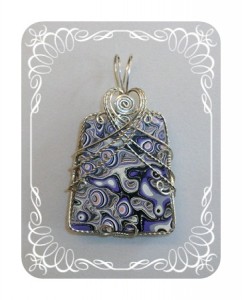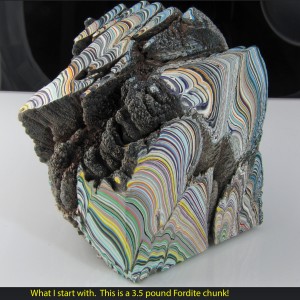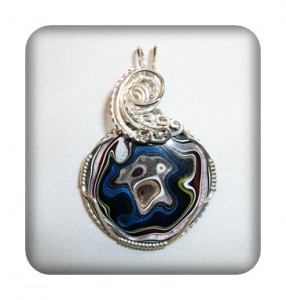- NEW DVD Series – Stone Setting with Bezels
- Tube Set Charm by Kim St. Jean
- Prong Basket Pendant by Kim St. Jean
- NEW DVD Series – Stone Setting with Cold Connections
- New DVD Series – Stone Setting with Wire
- NEW DVD Series: Introduction to Stone Setting by Kim St. Jean
- Featured Tool: Bracelet Bending Plier
- NEW Dvd by Eva Sherman
- Fun, Fast Fold Forming DVD Series
- Double Band Ear Cuff from Alex Simkin
Gem Profile Feb. 1: Fordite
by Layna Palmer, Wire-Sculpture.com

Fordite
Shop Designer OOAK Cabochons on Wire-Sculpture
Who doesn’t love a great car? The “new car” smell, the iconic designs, the beautiful paint in a rainbow of colors, and the pleasure of taking a wonderful machine on new and exciting adventures. The automobile has been the standard of the American culture for more than a century, and we still love our vehicles! Personally, I love fast cars… you know, the ones that set land-speed records and sound like a growling jet engine… but alas, I drive a mini-van. Until the kids are grown and gone, I will substitute my “need for speed” with a great roller coaster ride, but I digress.
Instead of talking about our favorite models and makes of cars, let’s talk about the paint. Automotive paint is one of those small things that is taken for granted, yet we tend to choose a vehicle based on the color of the paint even more than the color of the upholstery! When Henry Ford first started rolling his products off the assembly line, he was asked what colors the vehicles came in. He replied, “Any color you want, as long as it’s black!” The painting process at this time was very time-consuming and tedious taking several days to paint, with a brush, each layer of black lacquer and allow it to dry. The workers at Ford Motors would rub the entire chassis down with pumice between each layer as well. This process often caused a bottle neck at the factory and slowed production. There had to be a better way.
Enter the DuPont Company
In 1924, DuPont, in conjunction with General Motors, developed a nitrocellulose paint lacquer that dried fast and came in several colors, the most popular of which was blue. They also developed a sprayer for the paint virtually eliminating the brushing process for painting. This was still an air-dried lacquer, but it was a faster process and sped up production at the factory. New paint came in the 1930s that was enamel instead of lacquer and it was baked on the the car’s frame. This paint lasted longer and retained its shine better over time. The automobile was mounted on an assembly stand and pulled into the painting room, sprayed by a person and baked in place, then pulled down the line for further assembly. The paint overspray on the walls and assembly stands would also be baked in place, making a very hard, thick product.
Over time, the layers of paint would build up and make it difficult to pull the car chassis through the painting process and the workers would chip the paint off the metal sleds and walls. In the 1960s and 70s, acrylic paint was introduced that was more durable and weather-resistant than the enamel being used at the time, creating a buildup of vibrant colors in defined layers on the overspray. Workers noticed this material building up, and they would clear it away and take it home, forming it into shapes. Voila…Fordite, or Motor Agate, was born!
About Fordite
Fordite is not really a gemstone, but the buildup of layer upon layer of acrylic enamel paint that has been baked over and over again, making it very hard and durable.

This purple, black, and white Fordite cabochon almost looks like birds-eye rhyolite, with the many small eyes! Wrapped by Joan Madouse.
The lapidary process for Fordite is similar to other stones, though care does need to be taken since it is in such defined layers and may have hairline cracks from the removal process at the factory. I couldn’t find any information about the hardness on Mohs scale, but it is a medium-hard material with some earlier specimens being a little softer due to the composition of the paint. That’s recycling!

Lee Zimmerman kindly allowed us to show you this image of Fordite rough, one that he has used to cut cabs from.
You may be wondering as to the lead content and safety of the paint. The paint is an acrylic material that does contain lead. Lead is absorbed into our bodies through breathing, our mucus membranes, ingestion, and occasionally through cuts or scrapes. However, inorganic lead that is contained in paint is not easily absorbed through our skin, even through a cut or scrape, so unless you are going to eat it, there is really no danger in wearing a piece of Fordite.

Joan Madouse wrapped this blue Fordite diamond-shaped pendant in sterling silver-filled wire. It could nearly have a bit of druzy in the middle!
There are several different types of Fordite some having separated colors and regular banding with a primer layer in between while other are color on color with metallics and limited color ranges. Add in the color from drips and swirls most likely from the walls and floor of the painting rooms, and you have very neat patterns.
Where is Fordite from?
Fordite also comes from several different places.
Great Britain has some beautiful specimens that not only have the opaque colors, but metallic and transparency to some of the layers too. Detroit Fordite, although not necessarily from Detroit, is American in origin and usually has a gray primer layer between the vibrant colors. Ohio Fordite is another American original and comes from the factories that painted vans, so the colors can be earth-tones of green and brown or the more vibrant colors of the 70s with yellow, orange and bright blues.
Why Fordite is a Collector’s Item
Automobiles are no longer painted in this way today, because the painting process is automated and the chassis charged to attract the paint molecules, so there is virtually no waste. Because of this, Fordite is a finite material that is quickly running out, but what a great piece of automotive history! (PS: if you dabble in polymer clay, check out Dee Wilder’s faux fordite here!)
Next week, we are going to be having another contest… but this time, we’re adding a trivia section! Watch the blog next Friday morning (Pacific time) for the quiz. You could win Wire-Sculpture.com gift certificates!
Resources & Recommended Reading
- Lead Poisoning
- DuPont History
- Evolution of Automotive Paint & Protectant Technology
- Fordite (Motor City Agate)
- Fordite on MinDat
- Fordite on Fordite.com
Gem Profile by Layna Palmer
Click to Receive Daily Tips by Email

























Alice
February 1, 2013 at 6:53 am
This is so fascinating. I love the facts you present on these non-gemstones and gemstones too. I also love your wire wrapping. I haven’t yet tried the wire wrapping; however, I did make a sterling silver cage for marbles that I made for myself and my two granddaughters. I intend to read everything you have on wire wrapping, but would buy a book too if you have one.
Beverly Bracken
February 1, 2013 at 8:04 am
Fordite is a new material to me, and even though it isn’t a real gemstone, the examples you have shared are absolutely beautiful! The story behind it is great. Guess I’ll be shopping for it soon (if I can afford it.)
One of the projects I’ve yet to accomplish is wire wrapping. Hope to start that soon. The wrapping used on these examples are incredible. I especially love the heart motif.
Keep up all your hard work in teaching us how to do things and for keeping us informed! Many Thanks! Bev
Chuck Thompson
February 1, 2013 at 8:10 am
I worked for a jewelry importer that brought in some material from Taiwan that was labled T STONE. It was made with many layers of laquer and fashioned into cabs and hoops. Those made with various shades of brown and black resembled the grain of wood.
Thank you for this very informative article.
Kelli Nelson
February 1, 2013 at 8:44 am
This is my FAVORITE material to work with~ My Uncle worked at Ford for 40 years!!!! That in its self is amazing to me, that he was at the same job for that long!!! Doesn’t happen to very many people these days….Anyway~ I made him the most Beautiful Belt Buckle with some Fordite~ He was amazed to find out what it was actually made of!!!Even more amazement at the Wholesale price I paid for it!!! He winked at me and said “if I only knew this years ago kiddo! We would both have retired years ago!!!!!”
I just wanted to share a “funny- close to home” story with everyone!!!! My Uncle was very Pleased to have a piece of his “History”
Thanks for allowing me to share this story here!!
Kelli Nelson
Osceola WI
Kathy
July 16, 2013 at 2:52 pm
How did you get the final polish on it? Can you spray it with enamel?
Layna
July 17, 2013 at 7:40 am
Hi Kathy, from what I’ve heard and read on lapidary sites, you begin the polish with some really fine sandpaper on a buffer or rotary tool and work your way up to about 1000 – 1400 grit, ending with a muslin cloth. Be careful not to take too much off with each swipe and keep the “stone” cool to avoid melting, it is paint after all. To preserve and protect the material, you can spray with a clear enamel after the polishing is finished.
Charlie
February 1, 2013 at 9:50 am
I love your Gem Profiles. I’ve learned so much about the different “rocks” since I’ve been reading these. Keep up the good work.
Heidi Rousseau
February 2, 2013 at 8:58 am
Wonderful article and very interesting.I would love to make some jewelry with fordite,I have never heard of it but several years ago I bought some manmade silver type stones(can’t remember the name)and made some nice pendants from them.Several people commented on them at the local rock and gem show and wanted to know where they could buy it.Think I got it in Quartsite,AZ.but not sure.
Heidi Rousseau
February 2, 2013 at 2:39 pm
I was just wondering what the JO stands for in the JOGS show in Tucson?
Rose
February 4, 2013 at 10:49 am
I’m not sure, Heidi, I’ll try and find out for you.
Lee Zimmerman
February 4, 2013 at 4:45 am
I am the one who supplied the photo of the large chunk of Fordite shown in this article. I have a couple of comments. Firstly, in regards to hardness-this is a tough call. I also cut Opals, which are relatively soft. Fordite is incredibly soft when it comes to sanding and drilling. However, it is also incredibly resilient. I have dropped more than my fair share of Fordite pieces onto the concrete floor of my facility and none of them have broken. And even though the material is soft, it don’t seem any more prone to scratching than Opals, or other soft stones. Secondly, with regards to delamination-sense the material is literally a waste material, there was obviously no concern about quality control during its creation. Depending on unknown variables, there can be a “dry” layer. When these dry layers appear, the material will break right along that layer. I have not personally experienced the stress cracks described in the article, but I have experienced the delamination because of the dry layer syndrome. Lastly, I would like to thank Layna for doing a great job with her article and for highlighting a truly fascinating gem of a non-gem stone!
Liz
February 4, 2013 at 5:08 pm
I hate to be a downer but what about the toxicity of this stuff? It comes from old car paint that was more than likely full of lead. No thanks, I think I will pass unless I can be reassured it is lead free.
Rose
February 4, 2013 at 5:20 pm
Yes Liz (it’s right below the picture of the “rough”).
Lead is not easily absorbed through the skin – that’s why lead crystal, like Swarovski, is safe to wear. Just be sure not to ingest it, and you should be fine.
And in my book, there are ways to wrap a cabochon pendant that prevent the stone from actually touching your skin. I’m not a big fan of lead myself, but making an extra-wide bundle on the frame, so I only ever touched the wire, would be just fine with me.
But of course, it your personal choice!
Angela L. Bonner
June 20, 2016 at 4:43 am
Hi there! I could have sworn I’ve been to this blog before but after browsing through many of the posts I realized it’s new to me. Regardless, I’m certainly pleased I discovered it and I’ll be bookmarking it and checking back often!|